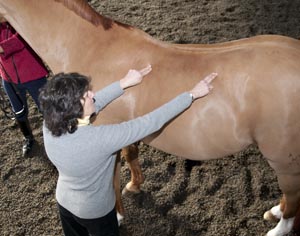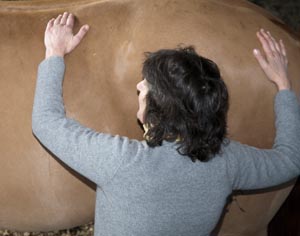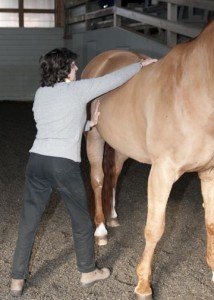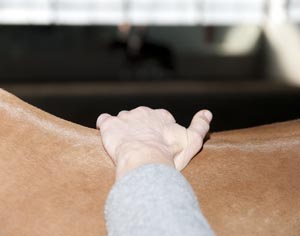How do you feel and behave when you get out of bed in the morning with tight or painful back muscles? Chances are you move stiffly or tentatively and your range of motion is restricted. Until you get relief, you don’t have your usual enthusiasm for normal tasks.

It’s much the same for your horse when his back muscles are stiff or hurting. He may
- flinch or sink away when you’re saddling him;
- travel with his head elevated and/or his back hollowed;
- canter less freely than usual;
- experience a decrease in coordinated power;
- trail his hind end rather than stepping under himself;
- jump flat rather than with a rounded bascule;
- drift sideways, either on the flat or over jumps;
- resist lateral work.
One thing your horse will not do as a response to back pain or tightness, by the way, is buck. He needs to round or flex his back to buck, whereas his normal reaction to pain and tightness in his back is to move away from the discomfort by hollowing.
As an Amazon Associate, Practical Horseman may earn an affiliate commission when you buy through links on our site. Product links are selected by Practical Horseman editors.
What’s Hurting
The muscles whose tightness is frequently a cause of these signs are the longissimus dorsi—the longest and largest muscles in your horse’s body and a powerful extensor of his spine—and the longissimus costarum, which lie below the longissimus dorsi across the ribs on each side and are important in lateral flexion of the spine and in breathing (see photos page 66 for the location of these muscles).

As part of understanding how tightness develops in these and other muscles, let’s take a quick look at how muscles work. Every muscle has two ends, each connected to bone by a tendon. One end is the anchor and the bone to which it is connected doesn’t move. The other end is connected to a bone that moves when the muscle is used. The middle part of the muscle, which does the work of moving the bone, is called the belly. It’s composed of hundreds of tiny fibers, each of which has its own blood supply. When a muscle is working normally, it tightens, then immediately relaxes or releases. Muscle tightness occurs when the muscle doesn’t release as it should. When a muscle becomes chronically tight, the fibers lie closer together. This constricts the flow of blood through the muscle belly, somewhat like stepping on a garden hose reduces the flow of water. The muscle operates less effectively when it’s tight, and it may be painful.
All muscles work in pairs of opposites: As one muscle contracts, its opposite releases. When a muscle is tight, the?release process of the muscle is affected. The back muscles extend the horse’s spine, and tight back muscles can’t release to allow for the spinal flexion your horse needs to, for instance, round himself for a bascule over a fence or a nice collected canter. Tightness in the longissimus costarum will also affect your horse’s ability to bend around your inside leg.
What Causes It
Back muscle tightness can result from a number of factors. Some of the most common are
- the strain and exertion of repetitive schooling, such as working much more on one canter lead than the other;
- footing that is very deep or too hard;
- an ill-fitting or out-of-balance saddle;
- a very imbalanced rider (whose horse will attempt to compensate for her ?one-sidedness);
- poor saddle placement (for instance, too far up on the withers, which drives the cantle into the back muscles);
- too many pads under a correctly fitted saddle. Contrary to some riders’ belief, this does not reduce pressure on the horse’s back but is more like cramming two pairs of socks inside your shoes.
Tight back muscles can also signal a deeper problem such as hock or ankle issues, weak stifles or ligament problems. How can you know whether you’re dealing with simple muscle tightness or with something more serious? If your horse’s discomfort is not relieved after you have done the massage and exercise sequence I’ll describe on the next two pages a couple of times, you need to involve your veterinarian. (As a general rule of thumb, in my 20 years of practice as a massage therapist, if I find persistent tightness in the forward area of a horse’s back, it may indicate a deeper problem in his front end; if the muscles remain tight in the area near his haunches even after massage, there may be a bigger problem in his hind end.)
Palpating for Tightness
When the training or performance problems I’ve described suggest your horse may have tightness in his back muscles, you can use palpation—simple hand pressure on the muscles—to get more information.

You’ll palpate the longissimus dorsi and longissimus costarum muscles on both sides of your horse’s spine. Whichever side you’re working on, position your horse so that the hind foot on that side is slightly to the rear of the foot on the opposite side. This configures his muscles to give you the best feel for what’s going on.
Starting near his withers where the longissimus dorsi begins, place the palm or heel of your hand on the muscle, push in gently, then release. Keep your elbow bent during this motion, which needs to be soft, yet firm. Work your way down the muscle, moving slowly and calmly. If the tissue rebounds as you release the pressure and fills your hand, the muscle is not tight. On the other hand, if the tissue feels unyielding like a board and does not rebound from pressure, the muscle is tight. When you palpate tight muscle tissue, your horse may move away from you because his instinct is to move away from pain. If the tightness is severe, he may hollow his back when you palpate an especially tight area.
Common palpation errors to avoid:
- running a hard object (such as a hoof pick or ball-point pen) down the length of his back;
- grabbing at the muscle with your fingers;
- jabbing or poking at the muscle with your fingertips.
All of these incorrect palpations stimulate sensitive nerve endings on your horse’s skin surface, causing him to flinch away whether the muscle tissue is tight or not.
After palpating the longissimus dorsi, follow the same procedure with the longissimus costarum.
For your bookshelf: Beyond Horse Massage: A Breakthrough Interactive for Alleviating Soreness, Strain, and Tension; Physical Therapy for Horses: A Visual Course in Massage, Stretching, Rehabilitation, Anatomy, and Biomechanics]
Massaging for Relief
If palpation suggests that one or both sets of these back muscles are tight, you can safely use a basic Wilson-Meagher Sportsmassage technique compression as a possible way of alleviating the problem. This is a technique anyone can use without extensive training.

Compressions are a way to gently spread the constricted muscle fibers, ?increasing the space between them for improved blood flow and gradually loosening the muscle. You perform them with an open hand, using the heel and palm for pressure while your fingers remain soft and extended but are not pressed into the muscle.
Begin with the longissimus dorsi at the forward-most point where it’s accessible, just behind the withers. Position yourself for stability as I’m showing in the photo at the top right of this page, so that your ?energy is directed from your foot up through your trunk and arm to your massaging hand. Place the heel of your hand on the muscle and press straight in and deep; your horse’s skeleton becomes the backdrop that enables the compression to spread the muscle fibers.
Using moderate pressure, apply about seven compressions every five seconds in a rhythmical pumping action, gradually working your way down the length of the muscle. Repeat the seven-compression sequence a few times in one spot, then move down. When you reach the point where the longissimus dorsi and the gluteal muscles of the hind end come together, keep going! The back muscles and the muscles of the haunches work together and massaging both will do a more thorough job. Repeat the compressions on the longissimus costarum, then move to the other side.
Check that your stance is correct and start again. Altogether, the massage will take you about 20 minutes.

Follow Up With Canter
To maximize the benefits of massaging his back muscles, ride your horse after you’re done and be sure to include several minutes of canter work in a stretchy but connected frame (not flopping on the forehand) in both directions. This kind of canter encourages your horse’s back muscles to lengthen and loosen. It’s the equine equivalent of the familiar back-stretching exercise you may use for yourself on those mornings when your back feels tight: bringing a knee to your chest.
If your horse’s problem is simple back-muscle tightness, you should see some improvement after the first massage/exercise session. You may need to repeat this another time or two for the most benefit.
The compression technique is useful when your horse shows signs of back-muscle tightness, and if you do it on a regular basis when no symptoms are present, it may prevent tightness from occurring. If the issue(s) that prompted you to try massage continue to be noticeable, of course, it’s time to contact your veterinarian.
Clinician, author, researcher and teacher, Jo-Ann Wilson is a nationally certified and licensed massage therapist. Jo-Ann produced an educational DVD, A Course in Equine Sportsmassage, and was selected to present educational seminars titled “Sportsmassage for the World’s Largest Athlete” at the 2010 Alltech FEI World Equestrian Games in Kentucky. She was sports therapist for both horses and riders of the US Eventing Team at the 2000 Olympic Games, and her current practice includes horses of all disciplines and levels. She is director of Wilson and Meagher Sportstherapy, a program that trains professional therapists in equine sportsmassage and offers workshops for horse owners; www.sportsmassageinc.com.
This article originally appeared in the April 2010 issue of Practical Horseman magazine.

